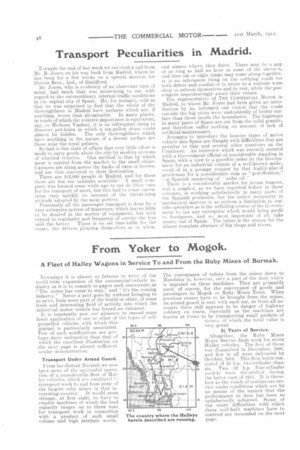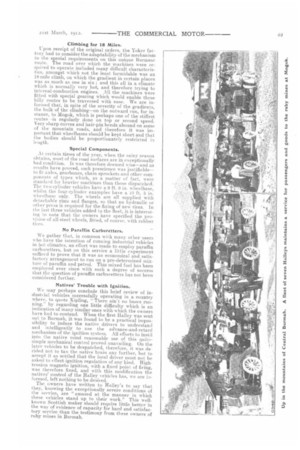From Yoker to Niogok.
Page 4

Page 5

If you've noticed an error in this article please click here to report it so we can fix it.
A Fleet of Halley Wagons in Service To and From the Ruby Mines of Burmah.
Nowadays it is almost as fatuous to write of the eorld-wide expansion of the commercial-vehicle industry as it is to commit to paper such statements as "The motor has come to stay," and "it's the coming industry." Never a post goes by without bringing to us news, from sonic part of the world or other, of some fresh and interesting field of activity into which the . industrial motor vehicle has forced an entrance.
haps more instructive than that of which the excellent illustration on the next page is almost sufficient ocular demonstration.
Transport Under Armed Guard.
From far-distant Burmah we now have news of the successful operation of a considerable fleet of Halley vehicles, which are employed ;transport. work to and from some of the largest ruby mines in that interesting country. It would seem strange, at first sight, to have to employ machines of which the load capacity ranges no to three tons for transport work in connection with a product of such small volume and high intrinsic worth. 'the conveyance of rubies from the mines down to Mandalay is, however, only a part of the duty which is imposed on these machines. They are primarily used, of course, for the conveyance of goods and passengers to Mogok or Ruby Mines Town. When precious stones have to be brought from the mines, an armed guard is sent with each car, as from all accounts there still appears to be danger of highway robbery en route, especially as the machines are known at times to be transporting small packets of stones, of which the total value is very great.
I00
Years of Service.
Altogether, the Ruby Mines Motor Service finds work for seven Halley vehicles. The first of these was dispatched in December, 1908, and five in all were delivered by October, 1910. This first batch consisted of 20 hp. two-cylinder chassis. Two 32 h.p. four-cylinder models were dispatched during the latter earl of 1911. It is therefore as the result of continuous service under conditions which are by no means of the easiest that the performance to date has been so satisfactorily achieved, Some of the many difficulties with which these well-built machines have to contend are recounted on the next page. Climbing for 18 Miles.
Upon receipt of the original orders, the Yoker factory had to consider the adaptability of the mechanism to the special requirements on this unique Burmese route. The road over which the machines were reAquired to operate included many difficult characteristics, amongst which not the least formidable was an 18-mile climb, on which the gradient in certain places was as much as one in six ; and this all in a climate which is normally very hot, and therefore trying to internal-combustion engines. All the machines were fitted with special gearing which would enable these hilly routes to be traversed with ease. "We are informed that, in. spite of the severity of the gradients, the bulk of the climbing—on the outward run, for instance, to Mogok, which is perhaps one of the stiffest routes -is regularly done on top or second speed. Very sharp curves and hair-pin bends abound on some of the mountain roads, and therefore it was important that wheelbases should be kept short and that the bodies should be proportionately restricted in length.
Special Components.
Al. certain times of the year, when the rainy season obtains, most of the road surfaces are in exceptionally had condition. It was therefore deemed wise—and as results have proved, such prescience was justifiable— to fit axles, gearboxes, chain sprockets and other components of types which, as a matter of fact, were standard for heavier machines than those dispatched. The two-cylinder vehicles have a 9 ft. 9 in, wheelbase, whilst the four-cylinder examples have a 10 ft. 5 in. wheelbase only. The wheels are all supplied with detachable rims and flanges, so that no hydraulic or other press is required for the fixing of new tires. In I he last three vehicles added to the fleet, it is interesting to note that the owners have specified the provision of all-steel wheels, fitted, of course. with rubber tires.
No Paraffin Carburetters.
We gather that, in common with many other users who have the intention of running industrial vehicles in hot climates, an effort was made to employ paraffin .carheretters, but on this service a little experiment sufficed to prove that it was an economical and satisfactory arrangement to run on apm-determined mixture of paraffin and petrol. This mixed fuel has been employed ever since with such a degree of success that the question of paraffin carburetters has not been .considered farther.
Natives Trouble with Ignition.
We may perhaps conclude this brief review of industrial vehicles successfully operating in a country where, to quote Kipling, "There ain't no buses running," by regarding. one little difficulty which is an indication of many similar ones with which the owners have had to contend. When the first Halley was sent out to Burmah, it was found to be apractical impossibility to induce the native drivers to understand and intelligently to use the advance-and-retard mechanism of the ignition system. All efforts to instil into the native mind reasonable use of this quitesimple mechanical control proved unavailing. On the later vehicles to be despatched, therefore, it was decided not to tax the native brain any further, hut to accept it as settled that the local driver must not be asked to effect ignition regulation of any kind. Hightension magneto ignition, with a, fixed point of firing, was therefore fixed, and with this modification the natives' control of the Halley vehicles has, we are informed, left nothing to be desired.
The owners have written to Halley's to say that they, knowing the exceptionally severe conditions of the service, are "amazed at the manner in which these vehicles stand up to their work." This wellknown Scottish maker should require little "better in the way of evidence of capacity for hard and satisfactory service than the testimony from these owners of :ruby mines in Burmah.




















